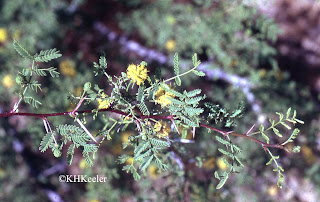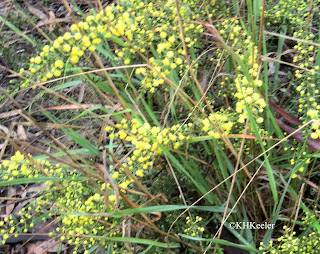Acacia koa, Hawaii
|
The current problem is the acacias. Acacias are trees and shrubs found in the Americas, Africa and Australia, with a few in southern Asia and on islands around the world. Historically they were in one huge genus with 1,540 species, the genus Acacia.
It has been clear for more than a decade that the acacias are not a single group but rather five groups of similar-looking plants. The subgroups (subgenera) of Acacia are being renamed as genera in their own right, bringing the names into line with the evidence, which is both molecular and morphological.
The problem was and is: which plants get to be called Acacia?
A proposal to the International Botanical Congress in Vienna in 2005 recommended changing how acacias are named. The proposal in Vienna gave the name Acacia to the biggest subgenus. It had to be a specific proposal because that biggest subgenus (Vachellia) does not include the very first species ever described with the name Acacia. Without the proposal, the rules require that the species in the biggest subgenus cease being Acacia species and become Racosperma species.
Acacia greggii, Arizona
|
The Proposal passed.
ant acacia, Costa Rica
|
Industries and governments all over the world have a stake in the name of plants they work with. They use Acacia in their names or publicity and don't want to have to deal with their plants becoming Vachellia or Racosperma. So we have not just botanists but powerful industries and their governments affected.
The common names are probably not at issue. In Australia they call Acacia species wattle, and will go on doing so whatever the scientific name is. Gilia aggregata was renamed Ipomopsis aggregata in similar split of a big genus, but it is still called scarlet gilia. Changing a scientific name does not necessarily change the plant's common name.
acacia in Australia
|
Again it passed, leaving the name Acacia with the largest, Australian, group of species.
There is still strong opposition. The Acacia issue will almost certainly be considered again at the next International Botanical Congress, which is in Shenzen China in 2017.
Most names and name changes are totally uncontested. The ongoing debate over Acacia emphasizes that people make nomenclature rules and that plant name changes can involve all sorts of people.
Comments and corrections welcome.
References
Smith, G. F. and E. Figueiredo. 2011. Conserving Acacia Mill. with a conserved type: What happened in Melbourne. Taxon 60(5): 1504-1506.
Thiele, K. R., V. A. Funk, K. Iwatsuki, P. Morat, C-I. Peng, P. H. Raven, J. Sarukhán and O. Seberg. 2011. The controversy over the retypification of Acacia Mill. with an Australian type--a pragmatic view. Taxon 60: 194-198.
World Wide Wattle - Australian acacia website http://www.worldwidewattle.com/
acacia in Australia
|
New Offer: I combined my blogs about plant names and the rules governing them into an ebook, entitled Botany Rules.
It's free.
To receive your copy click here: Botany Rules ebook
P.S. It will put you on my mailing list but I won't abuse your mailbox and you can unsubscribe at any time.
Kathy Keeler, A Wandering Botanist
More at awanderingbotanist.com
Join me on Facebook





No comments:
Post a Comment